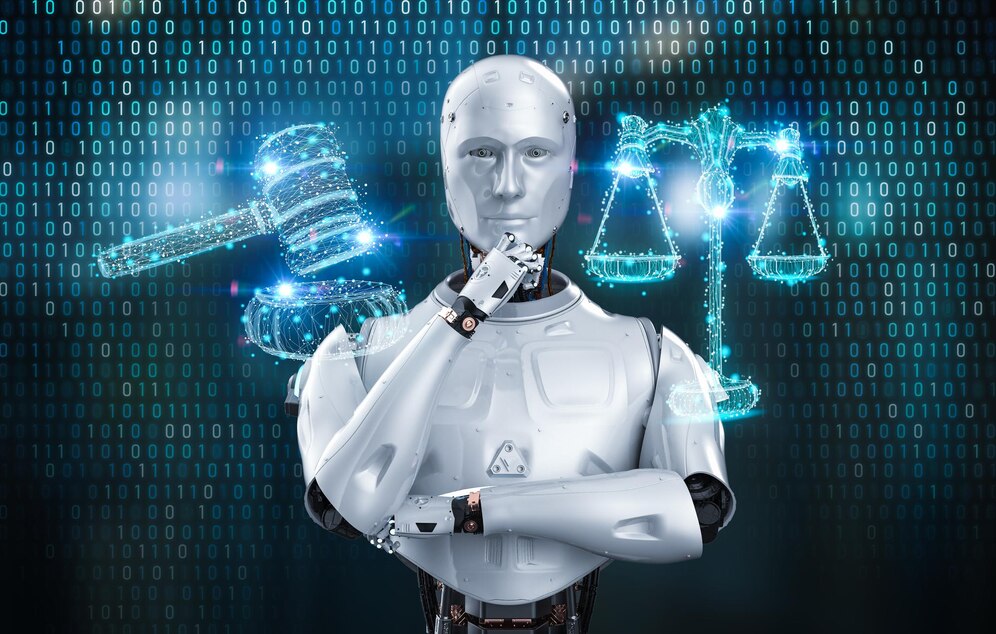Building an AI Judge for Tort Law over Lunch

Fusing Machine Learning and Judicial Reasoning for Tort Law Analysis
For legal scholars, practitioners, and technologists alike, the intersection of machine learning and judicial decision-making is an area rife with both opportunity and challenges. In the domain of civil tort law, we have undertaken an endeavor to develop an AI system capable of analyzing past cases and providing guidance on likely outcomes of new matters based on factual and legal similarities. Our approach combines the latest data-driven AI techniques with formalized representations of legal knowledge. Here, we share insights into the system’s architecture and development process.
Feature Engineering from Legal Corpora
The initial hurdle was deriving a high-dimensional feature representation of tort cases from largely unstructured court documentation. We utilized state-of-the-art natural language processing methods to extract structured data elements such as tort type, legal tests applied, listing of harms/injuries, assignment of liabilities and more. This textual data was further enriched through unsupervised learning of legal concepts and semantic embeddings customized for the tort law corpus.
Topology of Judicial Reasoning
In addition to the statistical patterns learned from data, we wanted to incorporate the logical rules and criteria that human legal experts employ in their reasoning. We constructed a knowledge graph encoding key tort doctrines such as duty of care, breach of duty, causation, and damages. This provided an ontological framework to map the learned features from data into a structured, interpretable basis aligned with judicial decision-making processes.
A Hybrid Model Unifying Data and Rules
The core of our system is a hybrid neural architecture combining multi-task learning models with the formal reasoning component based on the knowledge graph. The neural networks learn a generalized representation directly from the data’s feature space. In parallel, the knowledge graph encodes logical rules to infer judgments from the feature activations. An overarching attention model fuses these two information streams into holistic predictions.
Interpreting the “Black Box”
A central innovation is the system’s inherent interpretability. We implement integrated gradients and other explainability techniques that allow tracing the reasoning path from inputs to outputs through the neural attention layers. Users can explore this end-to-end decision provenance, grounded in terminology familiar to the legal domain. We believe such transparency is crucial, especially in AI systems operating in sensitive domains like judicial decision-making.
Incorporation of Human Feedback Loops
While powerful, our models are not intended to be autonomous. Instead, they function as knowledge assistants amplifying human legal expertise through intelligent querying and mixed-initiative interactions. We have developed intuitive interfaces allowing judges, lawyers, and subject matter experts to scrutinize the AI’s predictions on a case, provide corrections, and directly feed those annotations into continual learning cycles.
Adversarial Scrutiny and Ethical Considerations
From the onset, we have prioritized the “AI Safety” aspect through techniques like adversarial training to identify blind spots. Legal AI systems can have profound real-world impacts, hence we instituted clear processes for human oversight, ethical reviews and principles of fair and accountable machine learning into the development lifecycle.
As this AI system transitions from research to production deployment, we look forward to collaborating further with legal scholars and practitioners. The combined strengths of machine learning and judicial reasoning can unlock new avenues for intelligent case law analysis, robust decision support, and ultimately improving access to equitable justice.
Outline of Steps.
1. **Data Collection and Preprocessing**
– Collaborate with legal experts to curate a comprehensive and representative dataset of California civil tort cases.
– Preprocess the data to handle missing values, outliers, and inconsistencies, leveraging established techniques and domain knowledge.
– Explore data augmentation techniques to address potential class imbalances.
2. **Feature Engineering**
– Apply linear algebra techniques, such as the fundamental theorem of linear algebra, to decompose the data into orthogonal and diagonal components, capturing the underlying structure of civil tort cases.
– Extract relevant features from the decomposed matrices, incorporating domain knowledge and expert guidance.
– Utilize natural language processing techniques to derive additional features from legal texts and case precedents.
3. **Model Architecture**
– Design a hybrid model architecture that combines neural networks with rule-based systems or knowledge graphs to leverage both data-driven and expert-curated knowledge.
– Incorporate attention mechanisms or other interpretability techniques to enhance transparency and explainability.
– Implement adversarial training or defensive techniques to improve the model’s robustness against potential attacks.
4. **Training, Validation, and Testing**
– Split the dataset into training, validation, and testing sets, ensuring proper stratification and representativeness.
– Implement techniques like cross-validation, early stopping, and regularization to prevent overfitting and improve generalization.
– Evaluate the model’s performance using appropriate metrics, considering potential class imbalances.
5. **Continuous Learning and Model Updating**
– Develop a mechanism for continuously updating and retraining the model as new civil tort cases and legal precedents emerge.
– Explore online learning algorithms or incremental learning techniques for efficient model updates.
– Implement versioning and auditing procedures for transparency and accountability.
6. **Human-AI Collaboration**
– Integrate a human-in-the-loop approach, allowing legal professionals to provide feedback, validate predictions, and collaborate with the AI system.
– Develop user interfaces and visualization tools to facilitate effective human-AI interaction and knowledge transfer.
– Establish processes for ethical review and oversight to ensure adherence to legal principles and ethical standards.
7. **Deployment and Monitoring**
– Deploy the finalized model in a secure and scalable environment, ensuring compliance with relevant regulations and data privacy requirements.
– Implement robust monitoring and logging systems to track performance, detect issues or drift, and enable timely interventions.
8. **Iterative Refinement and Continuous Improvement**
– Regularly review and refine the model based on user feedback, performance evaluations, and evolving legal landscapes.
– Foster collaboration between computer scientists, legal experts, and domain specialists to continuously improve accuracy, fairness, and real-world impact.
Here is a 60-minute lesson plan for teaching the streamlined approach to developing an AI system for analyzing California civil tort law cases:
Lesson Objectives:
By the end of this lesson, students will be able to:
- Understand the importance of collaborating with legal experts in data curation and preprocessing
- Explain the use of linear algebra techniques for feature engineering in legal data
- Describe the components of a hybrid model architecture for legal analysis
- Understand the importance of adversarial robustness, human-AI collaboration, and ethical considerations in legal AI systems
- Outline the steps for continuous model updating, deployment, and iterative refinement
Introduction (10 minutes):
- Introduce the importance of AI in the legal domain, specifically for analyzing civil tort cases.
- Highlight the challenges of working with legal data and the need for a comprehensive approach.
- Present the lesson objectives and provide an overview of the streamlined approach.
Main Activities (40 minutes):
Data Collection and Preprocessing (10 minutes):
- Teaching Method: Interactive lecture with examples
- Discuss the importance of collaborating with legal experts to curate a representative dataset.
- Explain common data preprocessing techniques for handling missing values, outliers, and inconsistencies.
- Introduce data augmentation techniques to address class imbalances in legal data.
Feature Engineering (10 minutes):
- Teaching Method: Guided exploration and discussion
- Explain the use of linear algebra techniques, such as the fundamental theorem of linear algebra, for decomposing legal data.
- Discuss the process of extracting relevant features from the decomposed matrices, incorporating domain knowledge.
- Highlight the use of natural language processing techniques to derive additional features from legal texts and case precedents.
Model Architecture (10 minutes):
- Teaching Method: Collaborative learning and problem-solving
- Introduce the concept of hybrid model architectures that combine neural networks with rule-based systems or knowledge graphs.
- Discuss the importance of interpretability techniques, such as attention mechanisms, for enhancing transparency.
- Explain the need for adversarial training or defensive techniques to improve model robustness.
Deployment, Monitoring, and Iterative Refinement (10 minutes):
- Teaching Method: Interactive lecture with visuals
- Discuss the steps for deploying the finalized model in a secure and scalable environment, considering compliance and privacy requirements.
- Explain the importance of robust monitoring and logging systems for performance tracking and issue detection.
- Highlight the need for continuous model updating, versioning, and auditing procedures.
- Emphasize the role of iterative refinement and collaboration between computer scientists, legal experts, and domain specialists.
Conclusion (10 minutes):
- Summarize the key aspects of the streamlined approach, reinforcing the learning objectives.
- Discuss the importance of human-AI collaboration, ethical review, and oversight in legal AI systems.
- Encourage students to explore real-world examples or case studies of AI in the legal domain.
- Invite questions and feedback from students to address any remaining doubts or concerns.
Resources and Materials:
- Presentation slides or digital whiteboard
- Interactive visualizations or coding examples (e.g., Python libraries for linear algebra, NLP, and hybrid models)
- Sample legal datasets or case studies
- Additional online resources or reference materials for further study
Assessment:
- Formative assessment: Observe students’ engagement, participation, and understanding during the interactive lectures and group activities.
- Summative assessment: Administer a short quiz or assignment that requires students to apply the learned concepts, such as proposing a hybrid model architecture for a specific legal task or outlining the steps for iterative refinement of a legal AI system.
Following tools and resources would be needed to finish the task of developing an AI system for analyzing California civil tort law cases, including API cost breakdown using open source and Devin AI:
Data Collection and Preprocessing:
- Access to legal databases or repositories of California civil tort cases (potential API costs for data access)
- Open-source data preprocessing libraries (e.g., pandas, NumPy)
- Natural Language Processing (NLP) libraries (e.g., spaCy, NLTK) for text preprocessing
Feature Engineering:
- Linear algebra libraries (e.g., NumPy, SciPy) for data decomposition and feature extraction
- NLP libraries (e.g., gensim, spaCy) for text feature extraction and embedding
- Domain knowledge and collaboration with legal experts
Model Architecture:
- Open-source deep learning frameworks (e.g., TensorFlow, PyTorch) for building neural networks
- Knowledge graph libraries (e.g., Neo4j, Apache Jena) for rule-based systems
- Interpretability libraries (e.g., SHAP, Captum) for enhancing transparency
Training, Validation, and Testing:
- Computational resources (e.g., GPU instances) for training deep learning models (potential cloud computing costs)
- Open-source machine learning libraries (e.g., scikit-learn) for preprocessing, evaluation, and model selection
Continuous Learning and Model Updating:
- Incremental learning libraries (e.g., Numpy, TensorFlow Datasets) for efficient model updates
- Version control systems (e.g., Git) and model management platforms (e.g., MLflow, DVC) for tracking and auditing
Human-AI Collaboration:
- User interface libraries (e.g., Streamlit, Dash) for developing interactive applications
- Data visualization libraries (e.g., Matplotlib, Plotly) for presenting model insights
Deployment and Monitoring:
- Cloud platforms (e.g., AWS, Google Cloud, Azure) for secure and scalable deployment (potential cloud computing costs)
- Monitoring and logging tools (e.g., Prometheus, ELK Stack) for performance tracking and issue detection
Iterative Refinement and Continuous Improvement:
- Collaboration tools (e.g., GitHub, Notion) for fostering interdisciplinary collaboration
- Continuous Integration/Continuous Deployment (CI/CD) pipelines for automated testing and deployment
In terms of cost breakdown, the following factors should be considered:
- Open-source Tools: Most of the mentioned libraries and frameworks are open-source and free to use, reducing the overall development cost.
- Cloud Computing Costs: Depending on the scale of the project and computational requirements, cloud computing resources (e.g., GPU instances, storage, data transfer) may incur significant costs.
- Data Access Costs: Accessing legal databases or data repositories may require subscription fees or API usage costs, which can vary based on the provider and volume of data.
- Human Resources: Collaboration with legal experts, data scientists, and software engineers may involve consulting fees or salary costs.
- GitHub Copilot/Devin AI: Devin AI is an AI development platform that can potentially streamline and accelerate the development process. The cost of using Devin AI would depend on their pricing model and the specific services or resources utilized.
It’s important to note that the actual cost breakdown would depend on the specific implementation details, the scale of the project, and the chosen tools and resources. A detailed cost analysis should be performed based on the project requirements and available resources.
5 Mins to Read: Bringing Law into Code: Representing Causes of Action with JavaScript Objects
8 Mins to Read: Unveiling the Hidden Math Behind Tort Law
10 Mins to Read: Building an AI Judge for Tort Law over Lunch
Contact: Troy@southpointeagency.com
Troy Trang
AI Prompt Engineer, Web developer
Staff & Writers
Our staff writers are highly experienced and well-versed in a variety of areas. Trust in our expertise to achieve the best outcome for your business.



















